Dawei Du
Kitware
Vidi: Large Multimodal Models for Video Understanding and Editing
Apr 22, 2025Abstract:Humans naturally share information with those they are connected to, and video has become one of the dominant mediums for communication and expression on the Internet. To support the creation of high-quality large-scale video content, a modern pipeline requires a comprehensive understanding of both the raw input materials (e.g., the unedited footage captured by cameras) and the editing components (e.g., visual effects). In video editing scenarios, models must process multiple modalities (e.g., vision, audio, text) with strong background knowledge and handle flexible input lengths (e.g., hour-long raw videos), which poses significant challenges for traditional models. In this report, we introduce Vidi, a family of Large Multimodal Models (LMMs) for a wide range of video understand editing scenarios. The first release focuses on temporal retrieval, i.e., identifying the time ranges within the input videos corresponding to a given text query, which plays a critical role in intelligent editing. The model is capable of processing hour-long videos with strong temporal understanding capability, e.g., retrieve time ranges for certain queries. To support a comprehensive evaluation in real-world scenarios, we also present the VUE-TR benchmark, which introduces five key advancements. 1) Video duration: significantly longer than existing temporal retrival datasets, 2) Audio support: includes audio-based queries, 3) Query format: diverse query lengths/formats, 4) Annotation quality: ground-truth time ranges are manually annotated. 5) Evaluation metric: a refined IoU metric to support evaluation over multiple time ranges. Remarkably, Vidi significantly outperforms leading proprietary models, e.g., GPT-4o and Gemini, on the temporal retrieval task, indicating its superiority in video editing scenarios.
LEARN: A Unified Framework for Multi-Task Domain Adapt Few-Shot Learning
Dec 20, 2024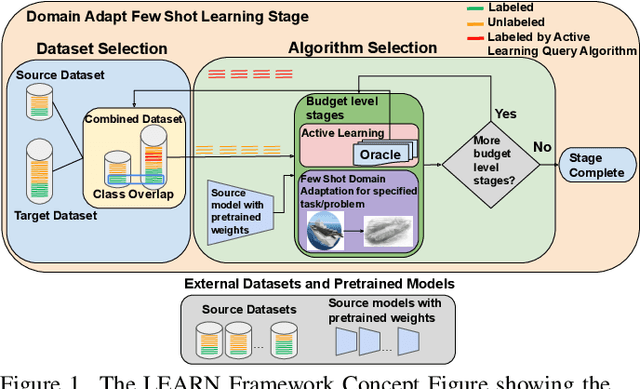

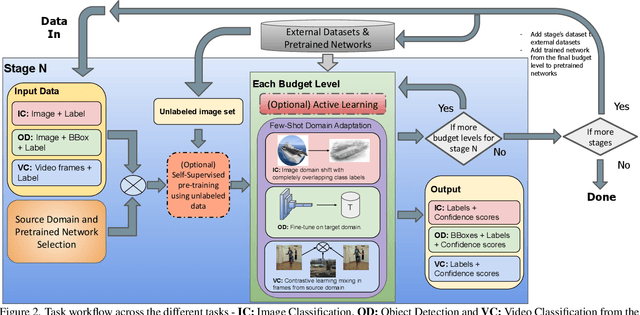

Abstract:Both few-shot learning and domain adaptation sub-fields in Computer Vision have seen significant recent progress in terms of the availability of state-of-the-art algorithms and datasets. Frameworks have been developed for each sub-field; however, building a common system or framework that combines both is something that has not been explored. As part of our research, we present the first unified framework that combines domain adaptation for the few-shot learning setting across 3 different tasks - image classification, object detection and video classification. Our framework is highly modular with the capability to support few-shot learning with/without the inclusion of domain adaptation depending on the algorithm. Furthermore, the most important configurable feature of our framework is the on-the-fly setup for incremental $n$-shot tasks with the optional capability to configure the system to scale to a traditional many-shot task. With more focus on Self-Supervised Learning (SSL) for current few-shot learning approaches, our system also supports multiple SSL pre-training configurations. To test our framework's capabilities, we provide benchmarks on a wide range of algorithms and datasets across different task and problem settings. The code is open source has been made publicly available here: https://gitlab.kitware.com/darpa_learn/learn
Beyond Raw Videos: Understanding Edited Videos with Large Multimodal Model
Jun 15, 2024



Abstract:The emerging video LMMs (Large Multimodal Models) have achieved significant improvements on generic video understanding in the form of VQA (Visual Question Answering), where the raw videos are captured by cameras. However, a large portion of videos in real-world applications are edited videos, \textit{e.g.}, users usually cut and add effects/modifications to the raw video before publishing it on social media platforms. The edited videos usually have high view counts but they are not covered in existing benchmarks of video LMMs, \textit{i.e.}, ActivityNet-QA, or VideoChatGPT benchmark. In this paper, we leverage the edited videos on a popular short video platform, \textit{i.e.}, TikTok, and build a video VQA benchmark (named EditVid-QA) covering four typical editing categories, i.e., effect, funny, meme, and game. Funny and meme videos benchmark nuanced understanding and high-level reasoning, while effect and game evaluate the understanding capability of artificial design. Most of the open-source video LMMs perform poorly on the EditVid-QA benchmark, indicating a huge domain gap between edited short videos on social media and regular raw videos. To improve the generalization ability of LMMs, we collect a training set for the proposed benchmark based on both Panda-70M/WebVid raw videos and small-scale TikTok/CapCut edited videos, which boosts the performance on the proposed EditVid-QA benchmark, indicating the effectiveness of high-quality training data. We also identified a serious issue in the existing evaluation protocol using the GPT-3.5 judge, namely a "sorry" attack, where a sorry-style naive answer can achieve an extremely high rating from the GPT judge, e.g., over 4.3 for correctness score on VideoChatGPT evaluation protocol. To avoid the "sorry" attacks, we evaluate results with GPT-4 judge and keyword filtering. The datasets will be released for academic purposes only.
Human Activity Recognition in an Open World
Dec 23, 2022


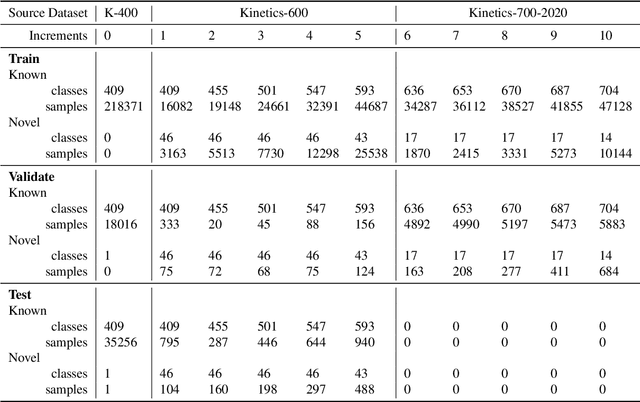
Abstract:Managing novelty in perception-based human activity recognition (HAR) is critical in realistic settings to improve task performance over time and ensure solution generalization outside of prior seen samples. Novelty manifests in HAR as unseen samples, activities, objects, environments, and sensor changes, among other ways. Novelty may be task-relevant, such as a new class or new features, or task-irrelevant resulting in nuisance novelty, such as never before seen noise, blur, or distorted video recordings. To perform HAR optimally, algorithmic solutions must be tolerant to nuisance novelty, and learn over time in the face of novelty. This paper 1) formalizes the definition of novelty in HAR building upon the prior definition of novelty in classification tasks, 2) proposes an incremental open world learning (OWL) protocol and applies it to the Kinetics datasets to generate a new benchmark KOWL-718, 3) analyzes the performance of current state-of-the-art HAR models when novelty is introduced over time, 4) provides a containerized and packaged pipeline for reproducing the OWL protocol and for modifying for any future updates to Kinetics. The experimental analysis includes an ablation study of how the different models perform under various conditions as annotated by Kinetics-AVA. The protocol as an algorithm for reproducing experiments using the KOWL-718 benchmark will be publicly released with code and containers at https://github.com/prijatelj/human-activity-recognition-in-an-open-world. The code may be used to analyze different annotations and subsets of the Kinetics datasets in an incremental open world fashion, as well as be extended as further updates to Kinetics are released.
Reconstructing Humpty Dumpty: Multi-feature Graph Autoencoder for Open Set Action Recognition
Dec 12, 2022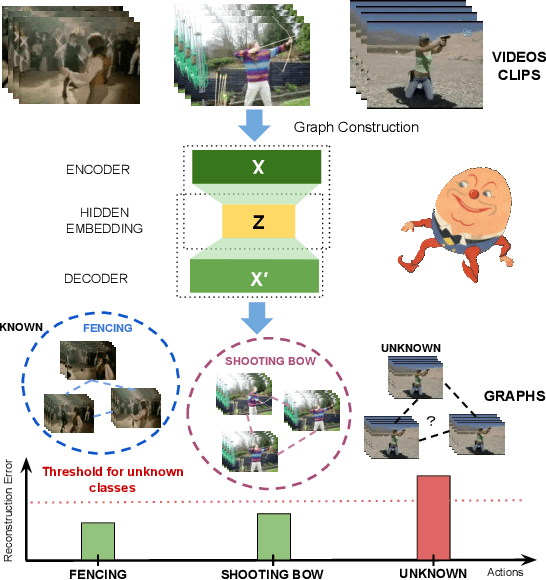



Abstract:Most action recognition datasets and algorithms assume a closed world, where all test samples are instances of the known classes. In open set problems, test samples may be drawn from either known or unknown classes. Existing open set action recognition methods are typically based on extending closed set methods by adding post hoc analysis of classification scores or feature distances and do not capture the relations among all the video clip elements. Our approach uses the reconstruction error to determine the novelty of the video since unknown classes are harder to put back together and thus have a higher reconstruction error than videos from known classes. We refer to our solution to the open set action recognition problem as "Humpty Dumpty", due to its reconstruction abilities. Humpty Dumpty is a novel graph-based autoencoder that accounts for contextual and semantic relations among the clip pieces for improved reconstruction. A larger reconstruction error leads to an increased likelihood that the action can not be reconstructed, i.e., can not put Humpty Dumpty back together again, indicating that the action has never been seen before and is novel/unknown. Extensive experiments are performed on two publicly available action recognition datasets including HMDB-51 and UCF-101, showing the state-of-the-art performance for open set action recognition.
MEVID: Multi-view Extended Videos with Identities for Video Person Re-Identification
Nov 10, 2022Abstract:In this paper, we present the Multi-view Extended Videos with Identities (MEVID) dataset for large-scale, video person re-identification (ReID) in the wild. To our knowledge, MEVID represents the most-varied video person ReID dataset, spanning an extensive indoor and outdoor environment across nine unique dates in a 73-day window, various camera viewpoints, and entity clothing changes. Specifically, we label the identities of 158 unique people wearing 598 outfits taken from 8, 092 tracklets, average length of about 590 frames, seen in 33 camera views from the very large-scale MEVA person activities dataset. While other datasets have more unique identities, MEVID emphasizes a richer set of information about each individual, such as: 4 outfits/identity vs. 2 outfits/identity in CCVID, 33 viewpoints across 17 locations vs. 6 in 5 simulated locations for MTA, and 10 million frames vs. 3 million for LS-VID. Being based on the MEVA video dataset, we also inherit data that is intentionally demographically balanced to the continental United States. To accelerate the annotation process, we developed a semi-automatic annotation framework and GUI that combines state-of-the-art real-time models for object detection, pose estimation, person ReID, and multi-object tracking. We evaluate several state-of-the-art methods on MEVID challenge problems and comprehensively quantify their robustness in terms of changes of outfit, scale, and background location. Our quantitative analysis on the realistic, unique aspects of MEVID shows that there are significant remaining challenges in video person ReID and indicates important directions for future research.
Unbiased Multi-Modality Guidance for Image Inpainting
Aug 25, 2022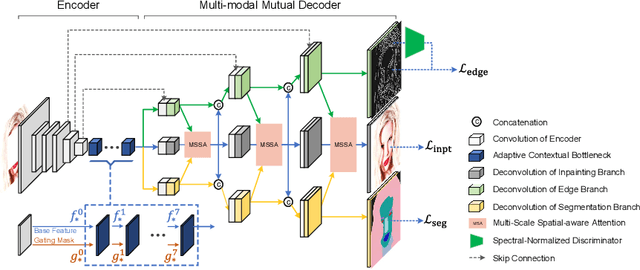
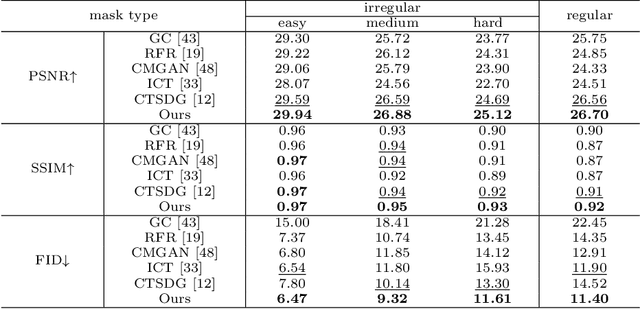
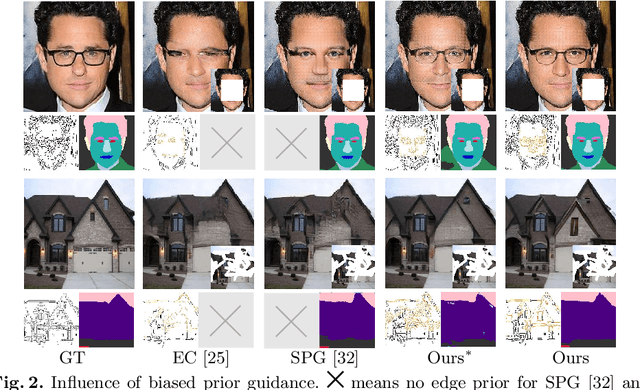
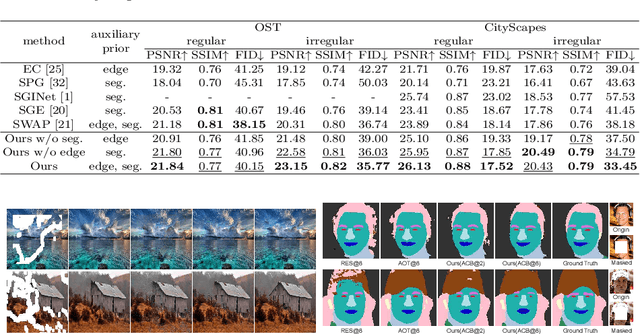
Abstract:Image inpainting is an ill-posed problem to recover missing or damaged image content based on incomplete images with masks. Previous works usually predict the auxiliary structures (e.g., edges, segmentation and contours) to help fill visually realistic patches in a multi-stage fashion. However, imprecise auxiliary priors may yield biased inpainted results. Besides, it is time-consuming for some methods to be implemented by multiple stages of complex neural networks. To solve this issue, we develop an end-to-end multi-modality guided transformer network, including one inpainting branch and two auxiliary branches for semantic segmentation and edge textures. Within each transformer block, the proposed multi-scale spatial-aware attention module can learn the multi-modal structural features efficiently via auxiliary denormalization. Different from previous methods relying on direct guidance from biased priors, our method enriches semantically consistent context in an image based on discriminative interplay information from multiple modalities. Comprehensive experiments on several challenging image inpainting datasets show that our method achieves state-of-the-art performance to deal with various regular/irregular masks efficiently.
Multi-Granularity Alignment Domain Adaptation for Object Detection
Mar 31, 2022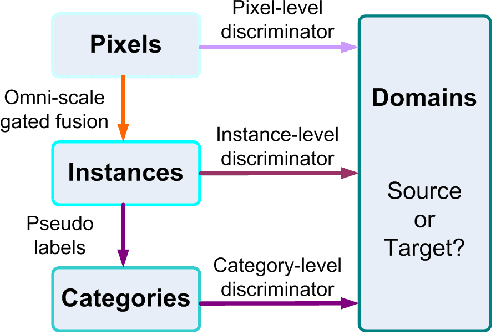
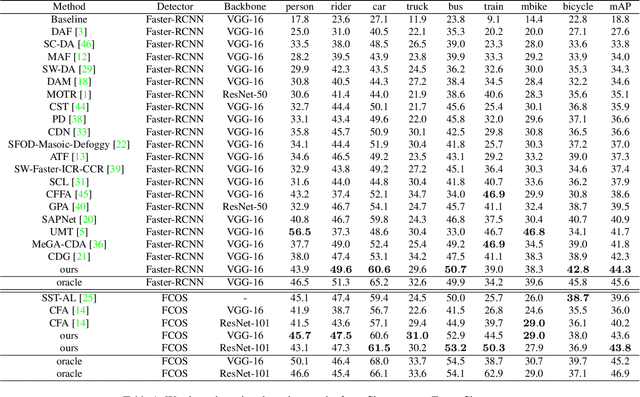
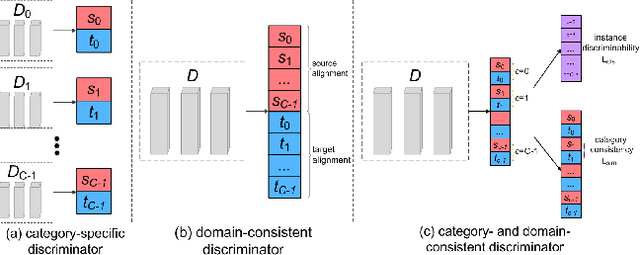
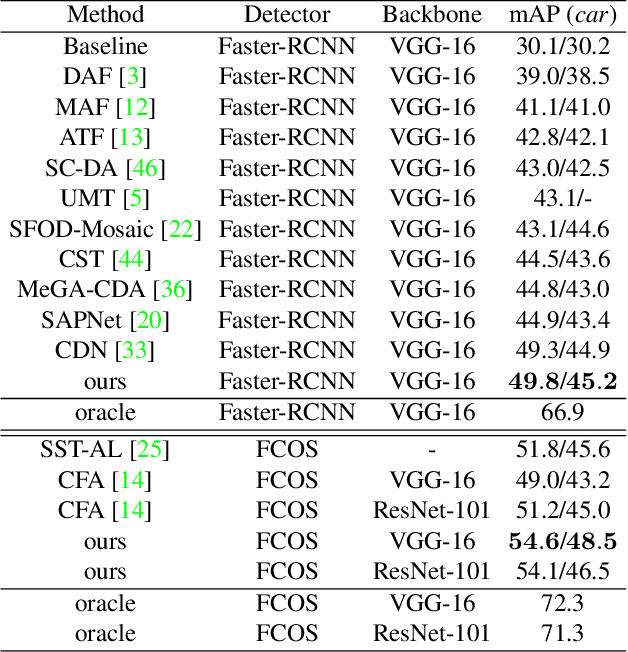
Abstract:Domain adaptive object detection is challenging due to distinctive data distribution between source domain and target domain. In this paper, we propose a unified multi-granularity alignment based object detection framework towards domain-invariant feature learning. To this end, we encode the dependencies across different granularity perspectives including pixel-, instance-, and category-levels simultaneously to align two domains. Based on pixel-level feature maps from the backbone network, we first develop the omni-scale gated fusion module to aggregate discriminative representations of instances by scale-aware convolutions, leading to robust multi-scale object detection. Meanwhile, the multi-granularity discriminators are proposed to identify which domain different granularities of samples(i.e., pixels, instances, and categories) come from. Notably, we leverage not only the instance discriminability in different categories but also the category consistency between two domains. Extensive experiments are carried out on multiple domain adaptation scenarios, demonstrating the effectiveness of our framework over state-of-the-art algorithms on top of anchor-free FCOS and anchor-based Faster RCNN detectors with different backbones.
Cascade Transformers for End-to-End Person Search
Mar 17, 2022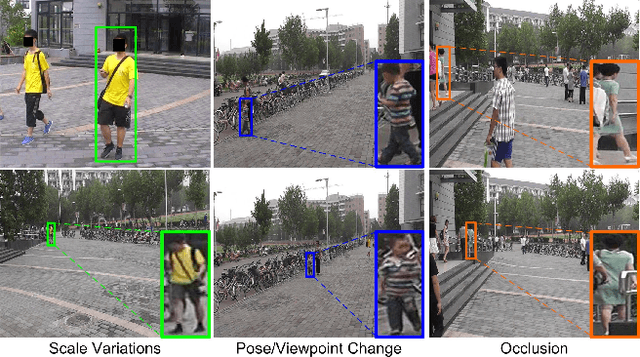
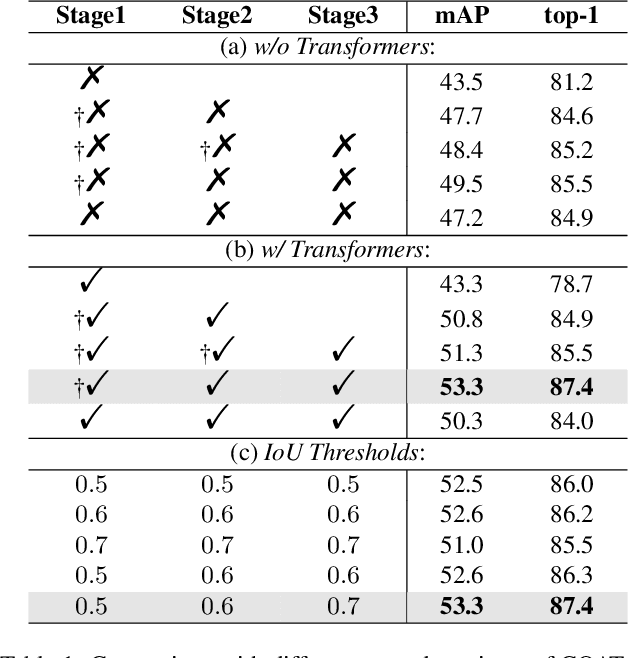
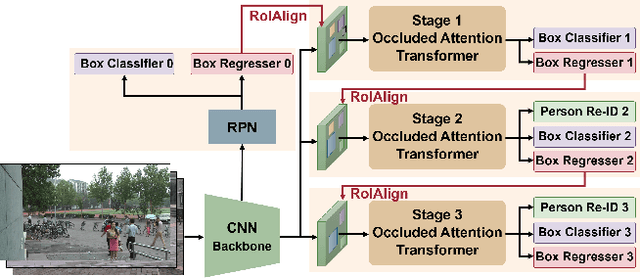
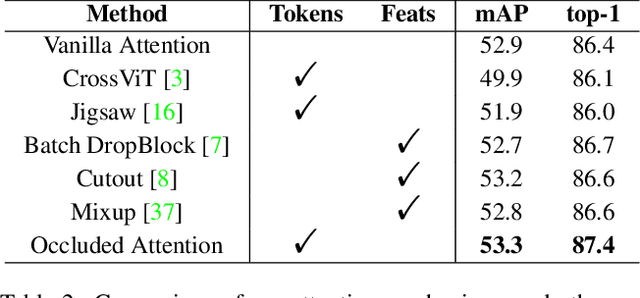
Abstract:The goal of person search is to localize a target person from a gallery set of scene images, which is extremely challenging due to large scale variations, pose/viewpoint changes, and occlusions. In this paper, we propose the Cascade Occluded Attention Transformer (COAT) for end-to-end person search. Our three-stage cascade design focuses on detecting people in the first stage, while later stages simultaneously and progressively refine the representation for person detection and re-identification. At each stage the occluded attention transformer applies tighter intersection over union thresholds, forcing the network to learn coarse-to-fine pose/scale invariant features. Meanwhile, we calculate each detection's occluded attention to differentiate a person's tokens from other people or the background. In this way, we simulate the effect of other objects occluding a person of interest at the token-level. Through comprehensive experiments, we demonstrate the benefits of our method by achieving state-of-the-art performance on two benchmark datasets.
VisDrone-CC2020: The Vision Meets Drone Crowd Counting Challenge Results
Jul 19, 2021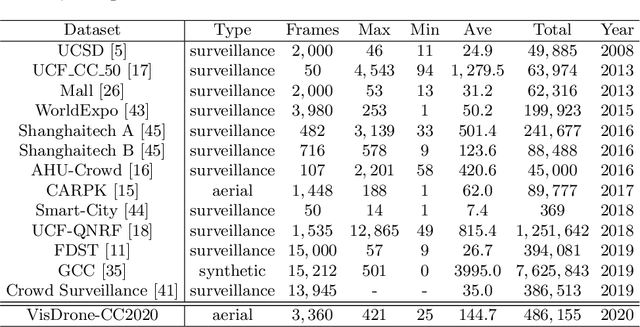
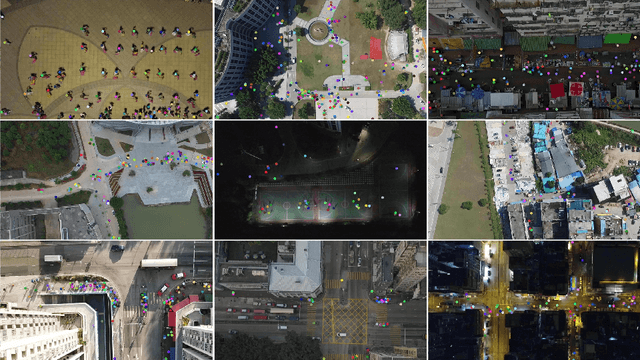
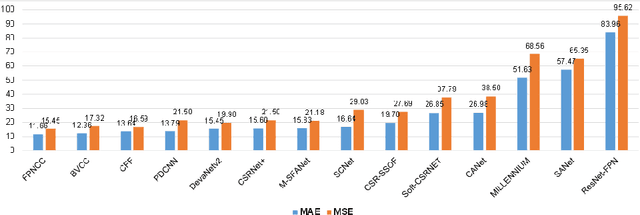

Abstract:Crowd counting on the drone platform is an interesting topic in computer vision, which brings new challenges such as small object inference, background clutter and wide viewpoint. However, there are few algorithms focusing on crowd counting on the drone-captured data due to the lack of comprehensive datasets. To this end, we collect a large-scale dataset and organize the Vision Meets Drone Crowd Counting Challenge (VisDrone-CC2020) in conjunction with the 16th European Conference on Computer Vision (ECCV 2020) to promote the developments in the related fields. The collected dataset is formed by $3,360$ images, including $2,460$ images for training, and $900$ images for testing. Specifically, we manually annotate persons with points in each video frame. There are $14$ algorithms from $15$ institutes submitted to the VisDrone-CC2020 Challenge. We provide a detailed analysis of the evaluation results and conclude the challenge. More information can be found at the website: \url{http://www.aiskyeye.com/}.
* The method description of A7 Mutil-Scale Aware based SFANet (M-SFANet) is updated and missing references are added
 Add to Chrome
Add to Chrome Add to Firefox
Add to Firefox Add to Edge
Add to Edge